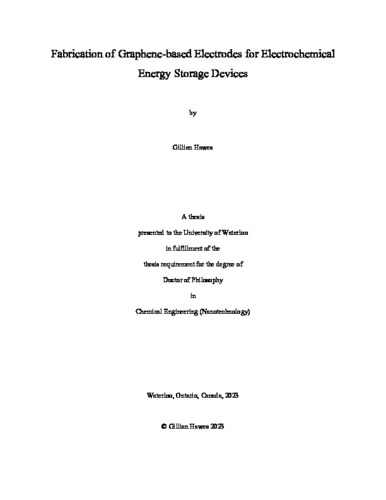| dc.description.abstract | Amid a global climate crisis, the urgent transition to net zero carbon emissions necessitates the development of improved electrochemical energy storage (EES) devices, such as batteries and supercapacitors. One of the most promising next-generation battery chemistries is lithium-sulfur, which possesses a theoretical energy density an order of magnitude higher than today’s widely used lithium-ion batteries. However, the effectively infinite volume change and unstable solid electrolyte interphase of the lithium anode along with the insulating nature of the sulfur cathode material remain critical challenges that limit the cycle life and energy density of current cells. Simultaneously, applications in regenerative braking, grid stabilization, and consumer electronics require devices with higher power densities and longer cycle life, which could be addressed via the use of supercapacitors, but the energy density of these devices requires improvement.
Graphene-based materials possess high specific surface areas and conductivities, as well as tunable morphologies, pore structures, and surface chemistries, making them particularly suited for EES electrode applications. However, processing of graphene-based electrodes introduces many challenges, including aggregation of graphene in the solid state, which limits the accessible surface area, and the frequent use of toxic solvents in solution-based processing. As such, this thesis focuses on the development of graphene-based electrodes for both supercapacitors and next-generation batteries via novel processing methods with the potential for improving sustainability.
In the first part of this thesis, we explore the fabrication of graphene-based electrodes via the laser-induced graphenization of polymer precursors, known as laser-induced graphene (LIG). This process enables the rapid production of porous, defective graphene active material as well as the patterning of advanced architectures. While LIG formation has previously been demonstrated on a range of materials, the areal capacitance of most devices has been limited, with high-performing devices nearly exclusively prepared from costly, petroleum-derived polyimide (PI, Kaptonᵀᴹ, ~4-9 mF/cm²). As such, we first study and introduce a new, easily processable, biomass-derived LIG precursor, poly(furfuryl alcohol) (PFA). We further study the implementation of additives into the PFA precursor to improve its surface area and capacitance. We demonstrate that supercapacitors prepared from composites of PFA microspheres and graphene oxide exhibit areal capacitances as high as 16.0 mF/cm² at 0.05 mA/cm², outperforming both GO and PI-based LIG supercapacitors reported to date. Following this work, we demonstrate that salt microparticle additives act as a template during LIG formation, resulting in BET surface areas that are an order of magnitude higher than LIG from pristine PFA, while simultaneously doping the LIG with different heteroatoms depending on the salt. As such, the multifunctional nature of these salts results in capacitances up to ~25 mF/cm² at 0.05 mA/cm², 2-4 orders of magnitude above that of LIG from pristine PFA, and among the highest capacitances reported for LIG to date.
Following the optimization of the LIG material, we study its implementation as a porous, 3D host for lithium metal anodes. While host structures are a common strategy to address the lithium volume change, little fundamental study has been reported to date on their rational design, with one of the guiding principles in literature thus far being that heteroatom doping of carbon hosts can improve lithium nucleation. As such, we study the nucleation of lithium metal on different LIG materials for the first time. We demonstrate that doping of the LIG with lithiophilic functional groups enables lower overpotentials for lithium nucleation, but also that doped samples exhibit shorter cycle life, indicating that careful optimization of the degree of doping is critical for lithium host design.
Finally, we develop a novel processing strategy to utilize graphene as a conductive scaffold for sulfur cathodes. Most fabrication methods for carbon/sulfur composites employ dry carbon powders, and are impractical for materials such as graphene, which are highly aggregated in solid powder form. Moreover, solution-based approaches typically use toxic organic solvents or costly electrochemically-inactive sulfur precursors. We demonstrate that high performance sulfur cathodes can be prepared via the nucleation and growth of sulfur on graphene from thus far relatively unexplored hydrophobic sulfur sols. Cathodes exhibit capacities as high as 1300 mAh/g(sulfur) (~4.8 mAh/cm²) and energy densities as high as 468 Wh/kg at 0.1C, demonstrating that this method can serve as a simple, scalable, aqueous-based route for the fabrication of high energy density cathodes. | en |

